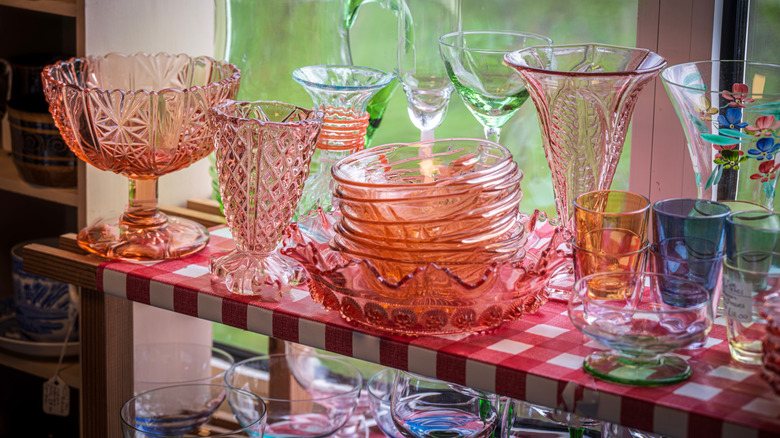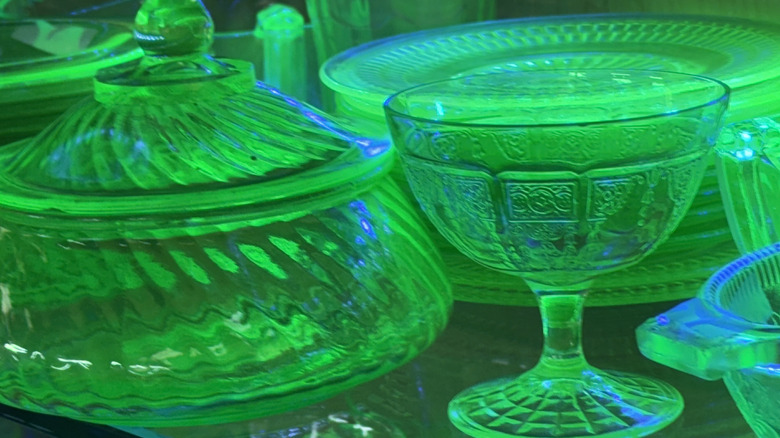The Most Valuable Depression Glass Colors To Search For At Thrift Stores & Estate Sales
We may receive a commission on purchases made from links.
Part of the fun of going to estate sales and thrift stores is searching for items that are valuable, but may be spread out on a table with other housewares — like the antique wine bottle opener forgotten among cheese knives and pickle forks. If you know what the good stuff is, however, such as the most valuable Depression glass colors to search for, then you can peruse those sales and stores with a plan in mind. It might not be very thrilling to come across the more common greens, pinks, and ambers, but Depression glass items in ruby red or aqua should have you reaching for them to take a closer look. And those two aren't the only uncommon shades. Colors like amethyst and ultramarine also make the list. Plus, just to make it a little more complicated, a particular pattern or manufacturer might be rare even though it's in a common color, like the Jeannette Glass Company's pattern, Cherry Blossom in pink.
If you're new to glass collecting (you may want to get a copy of the Collector's Encyclopedia of Depression Glass) and wondering, what is Depression glass, the first thing to know is that it really did get its start in the Great Depression. You should also know that Depression glass was manufactured rather than hand-blown and had a lot of flaws in it. Businesses often gave away pieces to entice people to shop in their stores or use their services. Little by little, families would collect dishes or serving pieces until they had a full set. Because they were in daily use, a lot didn't survive, making them more valuable today.
Finding Depression glass items in valuable rare colors
In an era when times were tough and luxuries scarce, people sought out whatever daily joys they could afford. Depression glass filled that need. What we now see as valuable glass items you should be looking for at thrift stores and estate sales were mass-produced items that helped businesses attract customers. Today, the most sought-after colors of the factory-produced glassware are amethyst, black, canary (yellow), cobalt blue, delphite (opaque pale blue), jadeite (a green hue), monax (opalescent white), red, white (milk glass), ultramarine, and uranium glass.
Finding Depression glassware in those more unusual shades can be a big win, but be sure you brush up on a few key indicators so you know how to spot authentic Depression glass when shopping at estate sales or thrift stores. For example, while some people think most of the Depression glass colors are beautiful, others see them as gaudy or kitschy, and that alone can be one way of spotting them at a thrift store or an estate sale. In addition, it helps to remember that the glass wasn't hand-blown; it was manufactured. That meant it was produced using molds and because of that, there was a seam. The Depression glass seam usually won't be smooth. You can also expect to see other flaws, such as air bubbles and small dings or divots.
Determining the value of a piece of Depression glass
Depression glass values vary widely depending on the pattern (design) of the piece, the style (candy dishes aren't rare at all, for example), the condition it's in, how rare it is, and of course, the color. Some colors were very popular and others were quickly out of circulation, making them more prized by collectors today. Then, there are those pieces that may have only been given away in limited quantities, having been produced in small batches, thus accounting for their scarcity and higher value.
Educating yourself in advance is helpful so that when you come across pieces like the Hocking Mayfair blue footed tumblers, which are valued at $720, you'll know to snap them up! Most of the time, you'll want to look for Depression glass that comes in colors that were much less common, like those that are amethyst, blue/aqua, yellow/canary, and uranium. Uranium glass is quite valuable, but you'll need to be careful of one health hazard when thrift shopping for this glass. Because it glows under a black light, you might see it displayed that way. Uranium glass, as you might suspect from the name, is radioactive. Think twice before buying it if it's chipped or cracked, or be diligent in wearing gloves when touching it, and never eat or drink from anything made with uranium glass.


